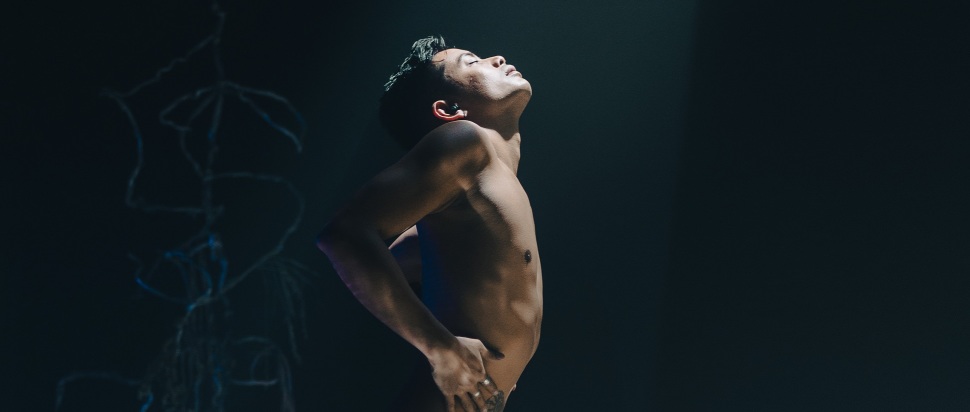Jian Yi on Weathervanes
We speak to Jian Yi about their inspiration and motivation behind Weathervanes, and the journey it has undergone to produce what is sure to inspire Fringe audiences this year
Journey to the East Productions presents Jian Yi’s Weathervanes, which will be transforming Summerhall this August at the Edinburgh Festival Fringe. It began as a solo piece of performance art, but Weathervanes’ latest manifestation takes the form of an immersive visual exhibit and ritual dance-theatre experience, creating an otherwordly living sculpture garden. Yi seeks to question what Western society has historically considered beautiful and holy by shifting the focus from cis, white bodies that have traditionally dominated the Occidental art space to people of colour and queer figures. Weathervanes provides a collaborative, dream-like space that invites the audience to join in the queer-naturist ritual activism taking place.
The Skinny: I’d firstly love to hear a bit more about what inspires you as a creative and how you discovered your love of dance.
Jian Yi: I think I've always been interested in the relationship and connection that performance has to our lives, society, and the times that we live in. I'm definitely inspired by avant-garde performance art, experimental theatre, dance, and the ways in which performance explores the human condition. I’m very much interested in how we can explore and experience transformational aesthetic encounters through performative ritual and how it can change us on some level. We've gone through different periods of history, like the 1960s and 70s, where there were more utopian ideas about how art is able to change society, but I still feel there is something powerful in art whether it overthrows capitalism or not. On a personal level, there's an encounter that happens with artwork, and that's what I always try to envision and explore.
I agree – so much changes over the centuries, but one thing that seems to stay at the core of human nature is the desire to create, to make art, to perform in some way – whatever form that takes. Are there any artists in particular who you take your inspiration from?
I have a background in Asian dance traditions such as Southeast Asian Trance and Japanese Body Weather. Weathervanes definitely draws on these choreographic traditions as an exploratory, slow, meditative exploration of movement. These non-Western traditions of dance in particular reflect a sense of ritual, something more sensual, extending beyond bourgeois society towards questions of afterlife, ancestral memory, and our elemental connection to nature.
You have spoken about focusing on queer bodies and groups who have historically been marginalised. Is this what motivated you to take it from a singular, personal piece to something much larger and more collaborative?
It’s developed stage by stage, unraveling all of these issues. Weathervanes is an immersive, ritual experience inspired by Western statuesque sculpture gardens where we see these beautiful white sculptures of bodies. We are trying to re-envision these traditions in art history and what they considered beautiful and holy by creating living sculptures with new queer POC figures. The work sort of channels focus on the living, full-bodied sensuality of the queer performers who are raised on elevated platforms and move through light and sound in a trance-like state. We're trying to create an architecture of queer futurity, inducing a dream-like state of mind for the audiences. I also believe that this is about connecting with the timelessness of ritual, queer ancestors and decolonial futures through our ongoing intersectional struggles. We’re advocating for radical self-acceptance and queer body image positivity. So yeah, I’m hoping that Weathervanes can really platform different perspectives while promoting psychic healing through dance intervention.
When we look at a statue, we inherently have a concept of who that person is while simultaneously putting them on a pedestal. The typical Western statue is of a white, cis body. I think that what you're doing is so beautiful because it radically questions that idea, using the physical form itself rather than words. For what feels like the first time, you actually encompass the global majority with a new perspective on non-cis bodies. Could you elaborate upon your view of the physical form and its connection with nature – why was it important for you to specifically place the body on this platform in such a way?
We call it Weathervanes because the performers’ bodies become these abstract weathervanes. This is conveyed through the slow moving performance in conjunction with the visuals. The performance installation asks the question of how to consider the human body and non-sexual nudity in a way that restores our connection to ourselves. That’s why we advocate for radical self-acceptance and queer body image positivity. Weathervanes as a project resists English puritanical impulses which associate the body with shame, fear and denial, inviting us instead to celebrate our corporeal nature. The show seeks a new standard and conception of what is beautiful and what is holy about ourselves.
Because the audience’s participation and response is so integral to the piece, is there any demographic or community in particular you would like to share it with? Is there anywhere that would really benefit from something so striking?
What’s so great about Weathervanes is that it’s a piece without dialogue so it doesn't involve any prior cultural understanding necessarily. It's about a universal human experience really, through the movement, music and dance. So we hope to be able to reach people in different contexts and environments. Mainland Europe tends to have a bit more of an openness towards nudity, for example, in comparison to the UK. At the same time it does important work when it challenges stereotypes and the conditioning that we have around shame and denial of the body.
Weathervanes, Summerhall Lower Cafe Gallery: live performances 3-6, 10-13, 17-20, & 24-27 Aug, 7.30pm & 9pm; visual arts exhibition 3-27 August, 11am-5pm
